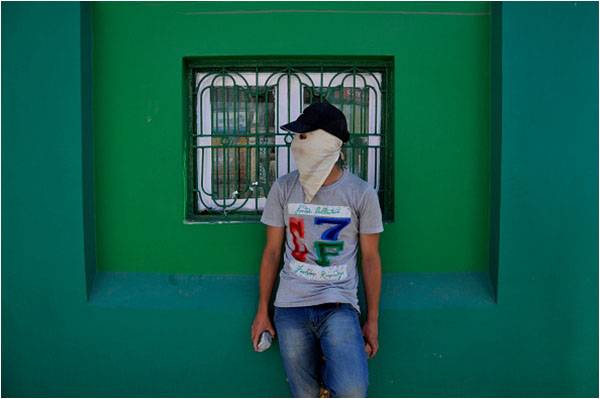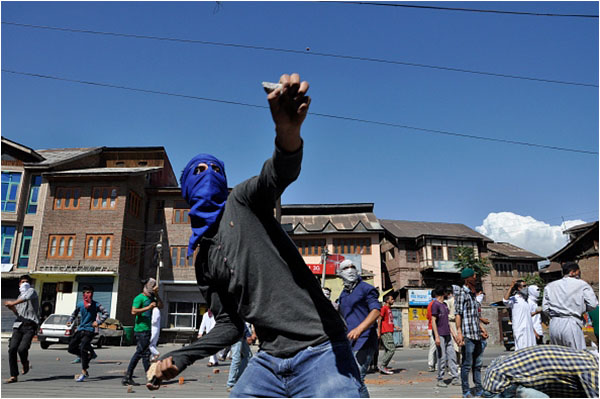
Indian Home Minister Rajnath Singh made a strong statement in the wake of the militant attack in Pampore in South Kashmir in which eight personnel of Central Reserve Police Force (CRPF) were killed. It was indeed an audacious attack that rattled the establishment from Srinagar to Delhi. Chief Minister Mehbooba Mufti even invoked the sanctity of the holy month of Ramzan to denounce the attack, saying that the assailants had disrespected their religion. Unnerved by the attack, Singh directly blamed Pakistan for destabilizing India. “Security forces have standing orders not to fire the first bullet, but not count bullets while retaliating,” he said in strong message to those he said were helped by Pakistan.
Renewed militancy:
An attack on a military or paramilitary convoy in Kashmir is not new, but the way both the sides – the militants and the security forces – have upped the ante in the past few months is suggestive of a new confrontation that has begun after what many call the new phase of militancy in Kashmir, dominated by the locals. A day before the Pampore attack, seven militants were killed in a gun battle in north Kashmir. The pattern that is shaping up in Kashmir is akin to what had been happening in Pakistan. The tit-for-tat game by the militants is becoming a routine here too, and that also brings home the point that despite being killed on a daily basis, militants are raising their head and showing their presence in the south if they are under attack in the north, and vice versa.
This resurgence of militancy in Kashmir is slowly taking the security situation back to square one. And in case this continues, it could lead to a situation where the involvement of the public cannot be ruled out. If there is a gun battle in a crowded area which results in a collateral damage, it could trigger a fresh round of public unrest as seen in 2010. Earlier too, when militants attacked the CRPF and took refuge in Entrepreneurship Development Institute (EDI) in the same area, people were rushing to the encounter site unlike the 1990s when they would run for a shelter just after the first bullet was fired. Women singing praises of militants and increasingly large funerals for them are indicative of how the people have started lending support to violence.
Mehbooba’s election:
However, the recent Anantnag by-poll that resulted in a thumping victory for Chief Minister Mehbooba Mufti is also a reality of today’s Kashmir. Although the turnout was low, people reposing faith in a chief minister whose People’s Democratic Party (PDP) was continuously despised for joining hands with the rightwing Bharatiya Janata Party (BJP) – at least on social media – thus opening doors for RSS in Kashmir, is very significant. She managed to double the margin of her father’s victory in December 2014, when PDP was riding on a wave of popularity and apparently asking people to vote for them to keep the BJP out. Mehbooba’s victory reveals the many layers of reality in Kashmir, and gives her strength to run a coalition with the BJP.
But the recurring attacks by militants pose a serious challenge to her as the head of the government. Nothing can be achieved in Jammu and Kashmir on the governance front unless the security environment remains relatively calm. A simmering militancy would divert the attention of the government and discount any good things done to improve governance. That is why political engagement to address the real issue is a must and cannot be left to only dealing with militants and counting how many were dead and how many left out to be chased. In the past three years, the dynamics of militancy in Kashmir have changed drastically. The involvement of local boys has made it difficult for the government to denounce it merely as a terrorist activity. In the absence of any effort to reach out to the political discontentment in Kashmir, militancy has revived and assumed the centre stage, with people openly allying with the gun wielding youth.

India-Pakistan hostility:
Rajnath Singh’s assertion that bullets fired in retaliation won’t be counted makes the situation worrisome. His direct blaming of Pakistan also suggests that the bonhomie that started between the two countries with Prime Minister Narendra Modi’s visit to Lahore in December last year has waned. After the Pathankot attack, no discernable forward movement could be seen. Even as India gave access to a Pakistani investigation team in Pathankot, that did not bring a change in the stressful relations between the two sides. The talks between the two national security advisors did break the ice at one stage, but it did not help the two countries reach a point where they could start addressing the critical issues one by one. As of now there, is no effort to even build the atmospherics. Those keeping an eye on the India-Pakistan situation are of the opinion that there is stalemate and the level of hostility has returned to its past high.
Pakistani Prime Minister Nawaz Sharif’s hand of friendship seems to be losing its grip. He apparently made a retired army general his national security advisor to keep the military in the loop. But India believes that infiltration continues, and the army does not seem to be on board.
New Delhi also failed to make any move to address Kashmir politically and continued with its policies of pushing the people to the wall. Pakistan contributed to the mess by hardening its stand vis-a-vis Kashmir. As of now, Kashmir has once again become a battlefield for both the countries to assert their legitimacy.
Militant violence in Kashmir is surely fill the vacuum created by a lack of political engagement. Both countries must move towards engagement and New Delhi also should recognize the realities on the ground and reach out politically to those who challenge its rule. Violence cannot be allowed to become a substitute to a political approach. Mehbooba’s comfortable victory in a violence-free election shows that people want a political reconciliation.
The author is a veteran journalist from Srinagar and the editor-in-chief of The Rising Kashmir
Renewed militancy:
An attack on a military or paramilitary convoy in Kashmir is not new, but the way both the sides – the militants and the security forces – have upped the ante in the past few months is suggestive of a new confrontation that has begun after what many call the new phase of militancy in Kashmir, dominated by the locals. A day before the Pampore attack, seven militants were killed in a gun battle in north Kashmir. The pattern that is shaping up in Kashmir is akin to what had been happening in Pakistan. The tit-for-tat game by the militants is becoming a routine here too, and that also brings home the point that despite being killed on a daily basis, militants are raising their head and showing their presence in the south if they are under attack in the north, and vice versa.
This resurgence of militancy in Kashmir is slowly taking the security situation back to square one. And in case this continues, it could lead to a situation where the involvement of the public cannot be ruled out. If there is a gun battle in a crowded area which results in a collateral damage, it could trigger a fresh round of public unrest as seen in 2010. Earlier too, when militants attacked the CRPF and took refuge in Entrepreneurship Development Institute (EDI) in the same area, people were rushing to the encounter site unlike the 1990s when they would run for a shelter just after the first bullet was fired. Women singing praises of militants and increasingly large funerals for them are indicative of how the people have started lending support to violence.
People are openly allying with the gun-wielding youth
Mehbooba’s election:
However, the recent Anantnag by-poll that resulted in a thumping victory for Chief Minister Mehbooba Mufti is also a reality of today’s Kashmir. Although the turnout was low, people reposing faith in a chief minister whose People’s Democratic Party (PDP) was continuously despised for joining hands with the rightwing Bharatiya Janata Party (BJP) – at least on social media – thus opening doors for RSS in Kashmir, is very significant. She managed to double the margin of her father’s victory in December 2014, when PDP was riding on a wave of popularity and apparently asking people to vote for them to keep the BJP out. Mehbooba’s victory reveals the many layers of reality in Kashmir, and gives her strength to run a coalition with the BJP.
But the recurring attacks by militants pose a serious challenge to her as the head of the government. Nothing can be achieved in Jammu and Kashmir on the governance front unless the security environment remains relatively calm. A simmering militancy would divert the attention of the government and discount any good things done to improve governance. That is why political engagement to address the real issue is a must and cannot be left to only dealing with militants and counting how many were dead and how many left out to be chased. In the past three years, the dynamics of militancy in Kashmir have changed drastically. The involvement of local boys has made it difficult for the government to denounce it merely as a terrorist activity. In the absence of any effort to reach out to the political discontentment in Kashmir, militancy has revived and assumed the centre stage, with people openly allying with the gun wielding youth.

India-Pakistan hostility:
Rajnath Singh’s assertion that bullets fired in retaliation won’t be counted makes the situation worrisome. His direct blaming of Pakistan also suggests that the bonhomie that started between the two countries with Prime Minister Narendra Modi’s visit to Lahore in December last year has waned. After the Pathankot attack, no discernable forward movement could be seen. Even as India gave access to a Pakistani investigation team in Pathankot, that did not bring a change in the stressful relations between the two sides. The talks between the two national security advisors did break the ice at one stage, but it did not help the two countries reach a point where they could start addressing the critical issues one by one. As of now there, is no effort to even build the atmospherics. Those keeping an eye on the India-Pakistan situation are of the opinion that there is stalemate and the level of hostility has returned to its past high.
Pakistani Prime Minister Nawaz Sharif’s hand of friendship seems to be losing its grip. He apparently made a retired army general his national security advisor to keep the military in the loop. But India believes that infiltration continues, and the army does not seem to be on board.
New Delhi also failed to make any move to address Kashmir politically and continued with its policies of pushing the people to the wall. Pakistan contributed to the mess by hardening its stand vis-a-vis Kashmir. As of now, Kashmir has once again become a battlefield for both the countries to assert their legitimacy.
Militant violence in Kashmir is surely fill the vacuum created by a lack of political engagement. Both countries must move towards engagement and New Delhi also should recognize the realities on the ground and reach out politically to those who challenge its rule. Violence cannot be allowed to become a substitute to a political approach. Mehbooba’s comfortable victory in a violence-free election shows that people want a political reconciliation.
The author is a veteran journalist from Srinagar and the editor-in-chief of The Rising Kashmir

